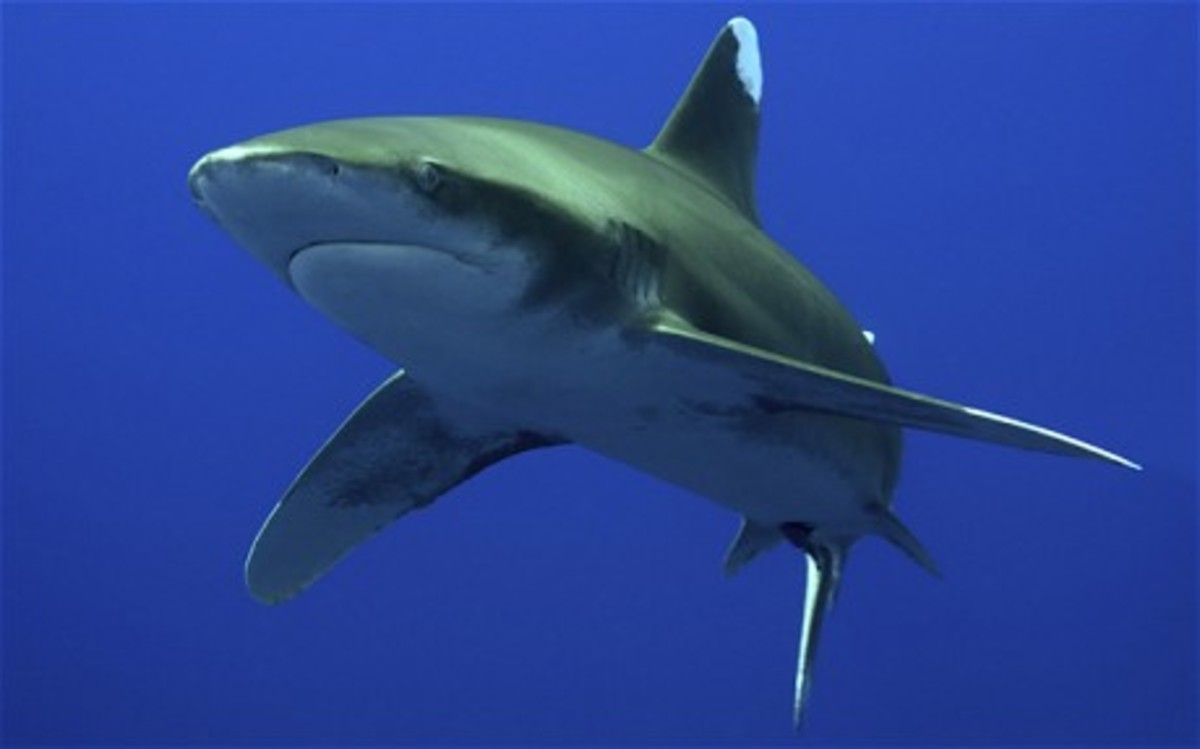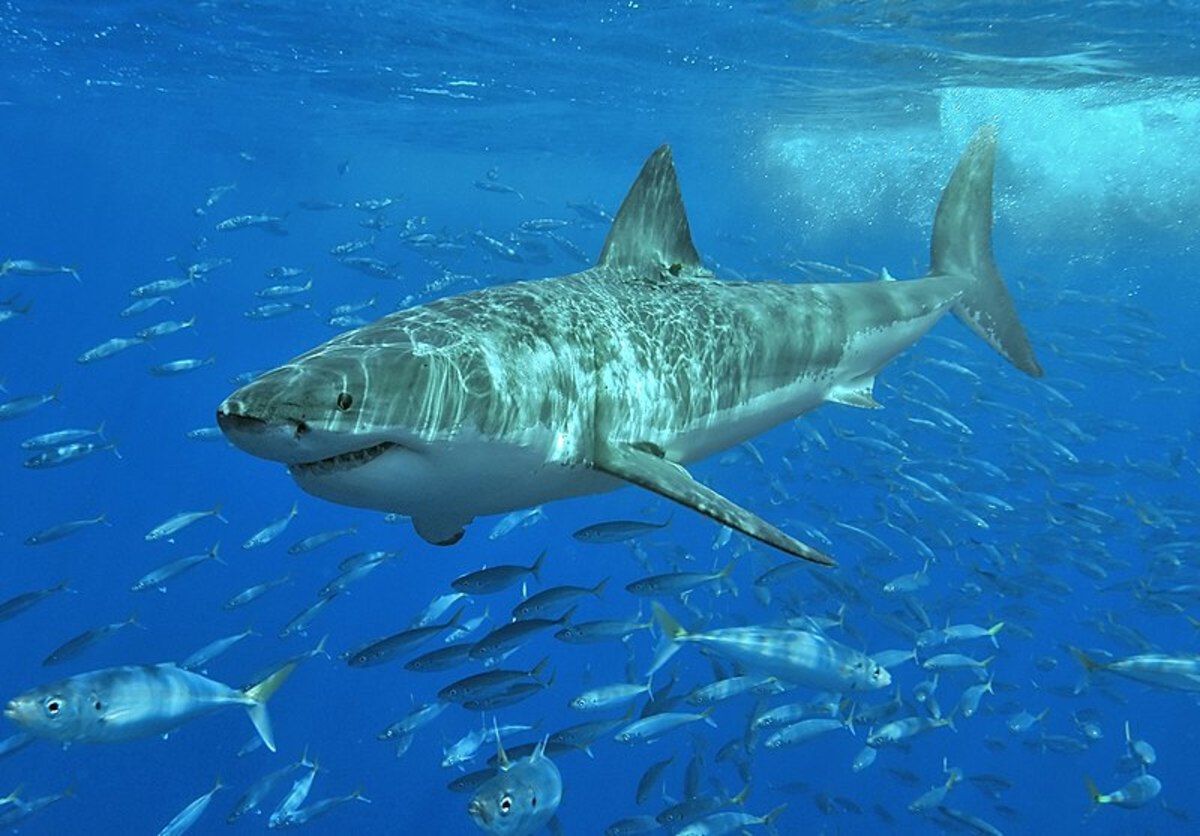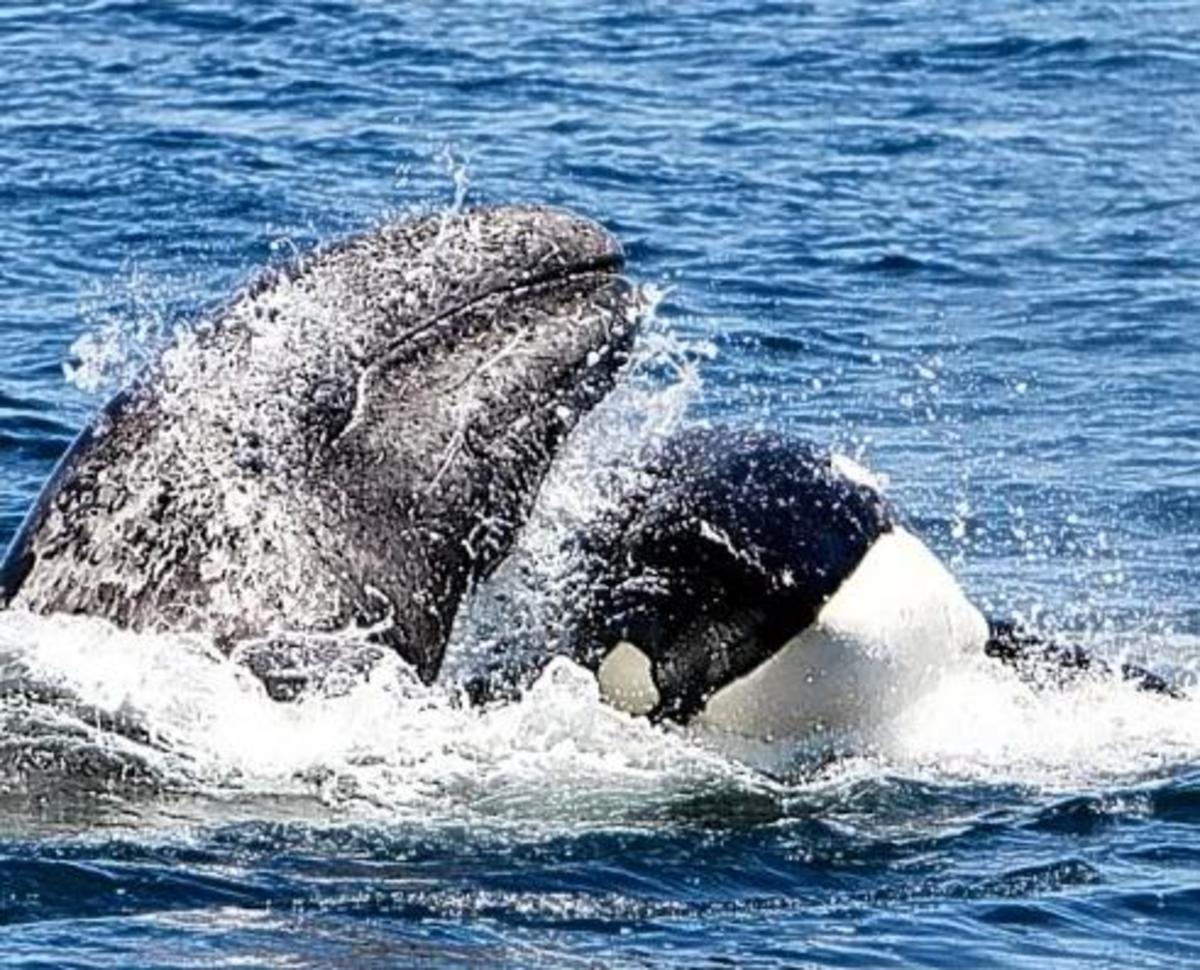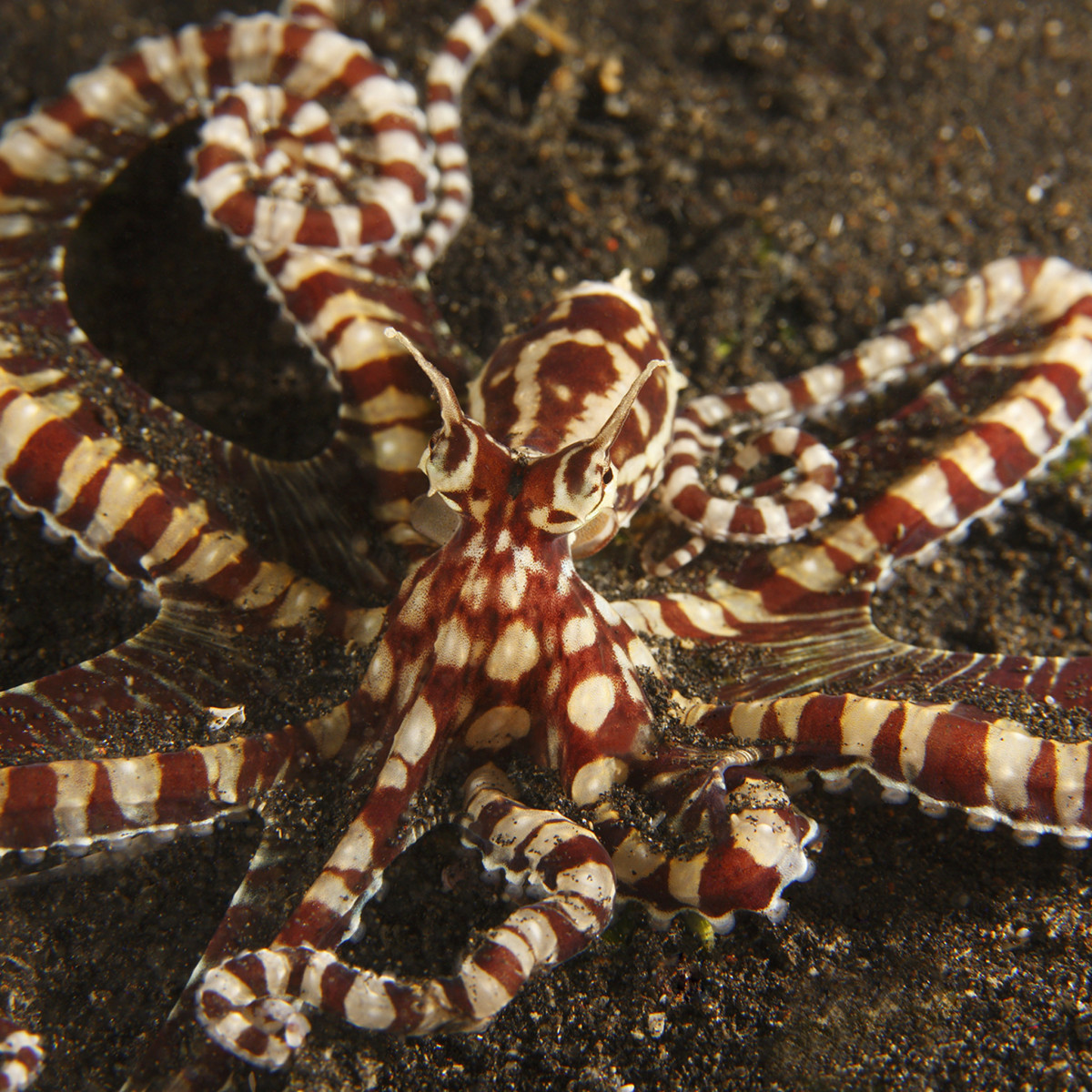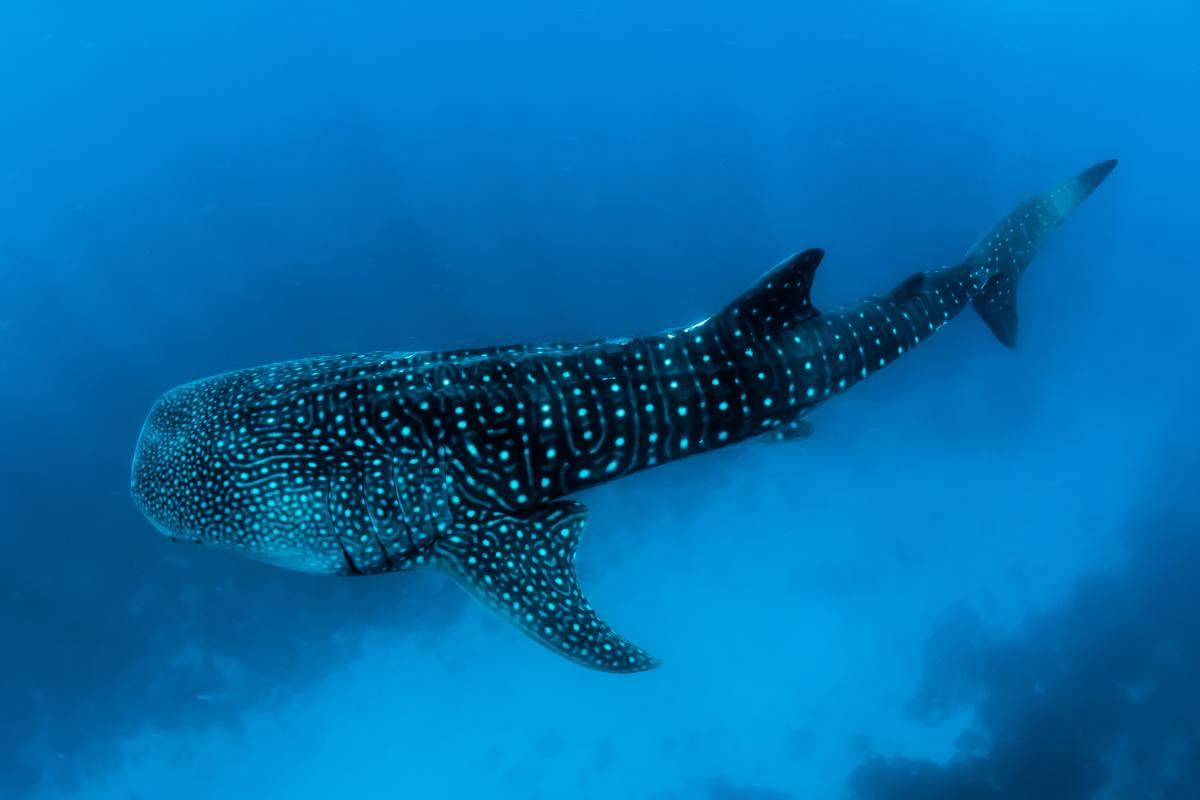- HubPages»
- Education and Science»
- Life Sciences»
- Marine Biology»
- Marine Life
Fast As a Shark: The Sea's Most Lethal Killing Machines
Nothing can ruin a day at the beach quicker than a shark sighting. But while these dangerously sleek creatures may pose an occasional threat to a swimmer or surfer, when observed in their natural habitat they can be both fascinating and beautiful! So why not join me in a journey to the deep, safe in the knowledge that these fellows cannot get you so long as you stay on dry land!
Oceanic Whitetip Shark (Carcharhinus longimanus)
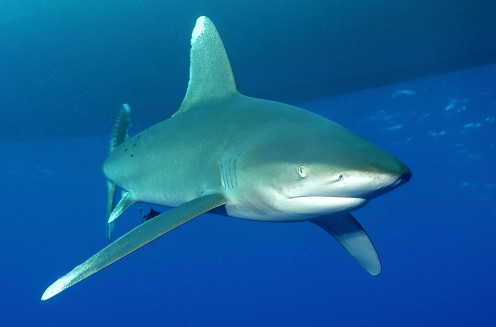
Jacques Cousteau once said the oceanic whitetip shark was "the only species of shark that is never frightened by the approach of a diver, and they are the most dangerous of all sharks." This is a view shared by many researchers, but there are relatively few shark attacks attributed to the whitetip. Since it is primarily a deep water resident, people rarely come into contact with this slow-moving but extremely powerful fish. It does pose a danger to shipwreck and airplane crash survivors, but rarely wanders close enough to shore to endanger recreational swimmers at beaches.
The oceanic whitetip shark is rarely found in groups but may occasionally spend time with other whitetips in areas with an adequate food supply. This aggressive shark is also known to dominate feeding frenzies when they occur. They are sometimes accompanied by remora, pilot fish, and dolphinfish despite shunning members of their own species. They are considered diurnal and may be active anytime regardless of day and night. In recent years, research has shown their worldwide population may be rapidly declining.
Great White Shark (Carcharodon carcharias)
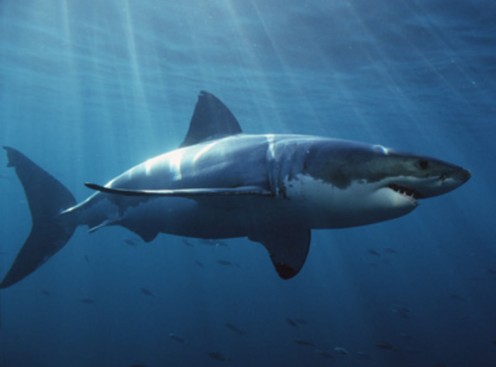
Probably the best known shark species, great whites can reach lengths of up to 20 feet. Females are larger with males usually topping out a couple of feet shorter than females. Though they can be found in almost all coastal waters with temperatures between the mid-50s and mid-70s °F, great whites have also been spotted at ocean depths as deep as 4000 feet. It has also been learned that great whites migrate and often travel great distances.
Great whites are ambush hunters, usually attacking from below while the prey is at or near the surface. They are carnivorous, eating everything from tuna, rays, dolphins, whales, seal, sea lions, sea otters, seabirds and even other sharks. They show intelligence by using different methods to attack different type prey. For instance, they always approach porpoise and dolphin from behind to avoid being detected by their echolocation abilities. They strike smaller prey with a killing blow but use an attack designed to disable flight with larger prey.
Longnose Sawshark (Pristiophorus cirratus)
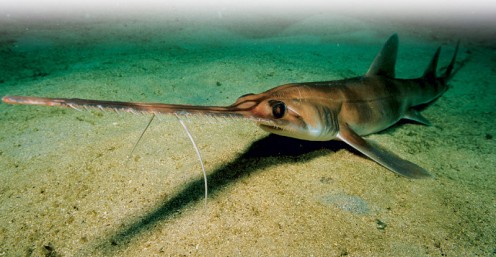
The longnose sawshark is also known as the common sawshark, presumably because it is the most common of the six species of sawsharks. Sawsharks are unfortunate creatures when it comes to the looks department. Their snout is a hideous looking saw that they use to slash and disable, though not necessarily kill, their prey. Which makes the sawshark something of a vicious beast.
Often sawfish are mistaken for sawsharks, but the easiest way to tell the difference is sawfish do not have the pair of barbels (that weird sort of mustache looking thing about halfway down the snout) that sawsharks do. Also, I have heard but do not know if it is true, that sawsharks are ticklish just beneath their chins. This method of checking the fish's identity is not recommended for those wishing to keep all their limbs.
Tiger Shark (Galeocerdo cuvier)
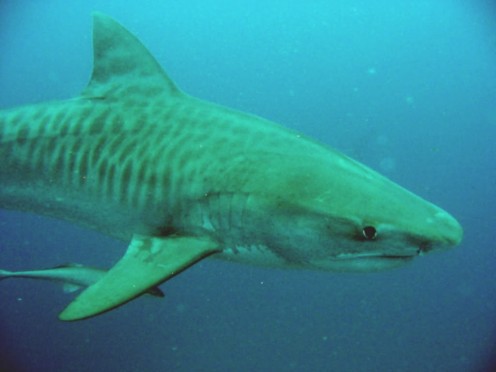
The tiger shark, which gets it name from the dark stripes it has covering most of its body, can commonly grow to more than 15 feet in length with some specimens reaching 20 or even 25 feet. As the tiger shark matures, its stripes fade.Tiger sharks can live up to 50 years in the wild and weigh up to 1900 pounds, though weights in the 850-1400 pound range are more common.
Tiger sharks are usually solitary hunters who are most active at night. Their diet includes everything from fish and smaller sharks to squids and turtles.They are part of a group of sharks known as requiem sharks. This family includes bull sharks, blue sharks and milk sharks. This family of sharks is migratory and give birth to live, fully developed young.
Tiger sharks are considered one of the most threatening sharks to humans. They tend to be found in tropical and sub-tropical coastal waters and like to go places such as shallow reefs and harbors where encounters with people can be fairly common. Unlike most sharks who tend to not like the taste of humans and turn away after taking a bite, tiger sharks do not seem to mind our flavor and continue to attack after the first bite. Second only to the great white on the list of sharks most likely to be involved in an attack on a human, tiger sharks are deadly sea predators who must be taken seriously.
Whale Shark (Rhincodon typus)
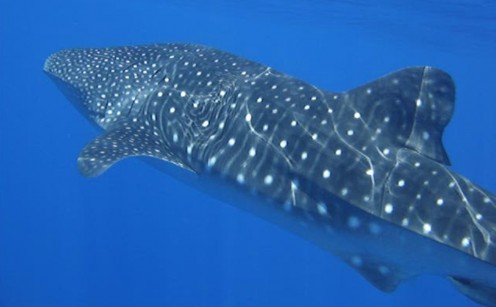
The whale shark is not related to whales in any way. Like other sharks, the whale shark is a fish whereas whales are mammals. But the whale shark is the largest known fish species and this is where the name comes from. Whale sharks have been confirmed at lengths greater than 40 feet and weights of almost 80,000 pounds. Sounds ferocious, huh? Wouldn't want to meet this bad boy at low tide, would ya?
Well, actually, the whale shark is a docile fish that even allows divers to hitch rides much like dolphins do. However, this is discouraged with whale sharks as their skin can be damaged causing infection to set in. These large fish will often play with swimmers and pose little danger other than an occasional accidental swipe of their powerful tail fins.
Spotted Wobbegong (Orectolobus maculatus)
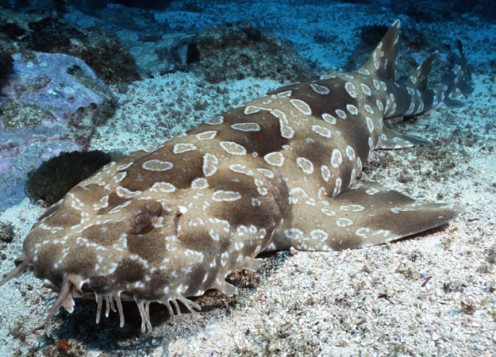
Found along the continental shelf that borders Australia in the Indian Ocean, the spotted wobbegong is fairly laid back when it comes to shark behavior. It spends its days hanging out on the ocean floor grabbing snacks that happen along and tickle the wobbegong's barbels. While the shark is considered to be a tasty seafood treat and its skin produces a beautiful, strong leather, the wobbegong is considered more of a nuisance to fisherman than anything else, often interfering in the harvesting of lobsters.
The spotted wobbegong poses little danger for humans as it is not an aggressive fish. Less than two dozen shark bites have been attributed to wobbegongs and those were generally due to the shark being stepped on or a limb getting too close to its mouth and being mistaken for prey. If they do bite, however, they are reluctant to let go, probably again thinking they have latched on to their dinner.
Goblin Shark (Mitsukurina owstoni)
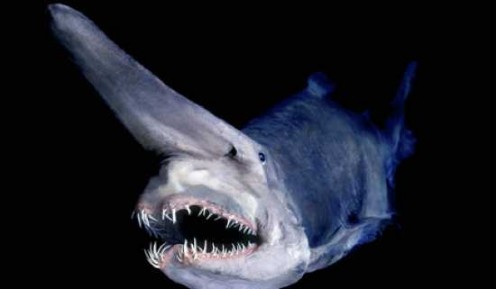
The goblin shark is a deep water fish that is rarely encountered by humans though it does occasionally finds its way into deep-sea fishing nets and has been seen in shallow waters around Japan. It is a very distinctive shark with a much longer snout than any other shark. It uses its snout to sense prey and then extends its jaws to capture it. Not much is known about this deep ocean dweller or its habits due to the limited interaction it has had with humans.
Pacific Angelshark (Squatina californica)
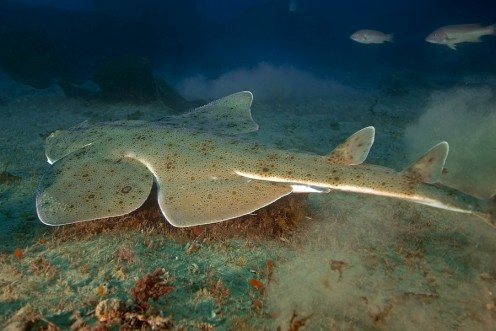
There are 16 recognized species of angelsharks and they are all quite beautiful. The Pacific angelshark is found in the eastern Pacific Ocean near the western coast of the Americas. It is a fairly small shark with a maximum length of less than 5 feet. It is tan and sometimes gray with many small round markings of a darker coloration. Its flat, wide body makes it appear similar to a ray, but they are totally different animals.
Angelsharks eat mostly bony fish including croaker, mackerels, sardines and various flatfish. They pose very little danger to people though they will bite if provoked or they mistake your foot for a tasty flounder. These amazing cool-looking fish rarely cause serious injury to humans but their bites can be very painful and require a trip to the hospital.
Scalloped Hammerhead (Sphyrna lewini)
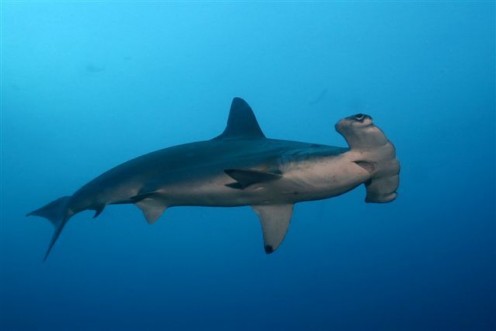
The scalloped hammerhead is the most common hammerhead shark in the world. It is sometimes called the bronze hammerhead, the kidney-headed hammerhead or the southern hammerhead. It is found in temperate and tropical coastal waters practically everywhere except eastern pacific Ocean along the western coast of the Americas. Hmm... maybe it doesn't get along with the Pacific angelfish?
(Anyone reading this to learn about sharks needs to know this was just a little joke. I am sure Pacific angelfish and scalloped hammerheads would get along just fine and it is purely coincidental that their particular habitats do not overlap even though it really is odd that those hammerheads are found in all other coastal areas except the one place you find the angelfish...)
The scalloped hammerhead is often seen in large schools, especially the younger hammerheads. They are not aggressive toward humans under normal conditions but should not be provoked. They eat mostly bony fish, squids and octopi and the occasional smaller shark. Like maybe the Pacific angelshark? I'm just saying!
Basking Shark (Cetorhinus maximus)
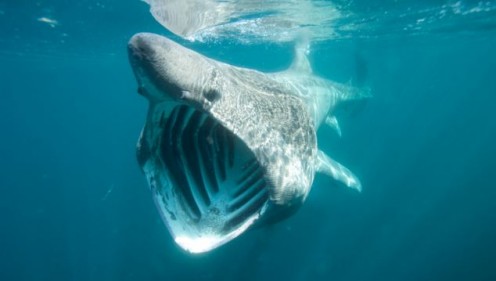
Second only to the whale shark in size, this huge fish also poses little to no danger to humans just like his larger big brother. Both the whale shark and the basking shark feed by filtering food from the seawater around them though the whale shark can pump water through its gills while the basking shark can only take in water by swimming through it. Though the basking shark has a mouthful of tiny teeth, they do not bite their prey and are considered generally harmless to people and other large aquatic life.
Lemon Shark (Negaprion brevirostris)
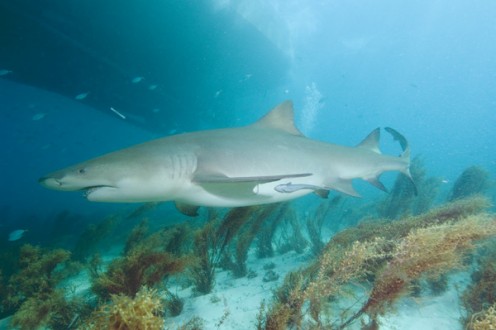
Lemon sharks get their name from the yellowish tint of their skin. The name may at first seem a little silly, but at lengths up to 10 feet and beyond, an encounter with one of these big fish is no laughing matter. Lemon sharks are found in the subtropical and tropical coastal regions of the Atlantic and Pacific coasts of North and South America as well as the Atlantic coast of Africa. The lemon shark is one of the most extensively studied shark as researchers have found it survives well in captivity, unlike many other sharks.
Brownbanded Bamboo Shark (Chiloscyllium punctatum)
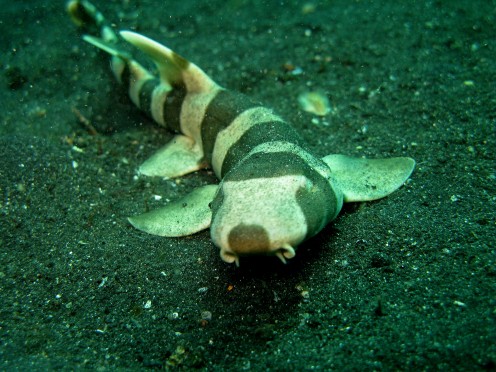
The brownbanded bamboo shark is mostly brown with very light bands when they are mature, but juveniles (like the one pictured above) have very distinctive markings. This very calm fish is commonly kept in aquariums as pets and is arguably the shark best suited to this purpose. it is a small shark, reaching only a maximum length of just over 40 inches. It is considered near threatened in the wild due to loss of habitat as well as fishing for food and aquarium stock. Bamboo sharks are also bred in captivity for the aquarium trade.
Spiny Dogfish (Squalus acanthias)
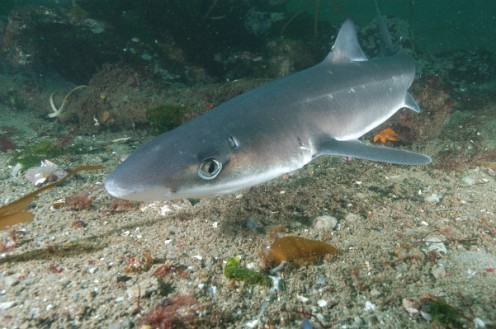
The spiny dogfish is commonly used for fish and chips in Great Britain and is also fished for food in the United States and Canada among other places. Males only reach a little over three feet but females can grow to around five feet in length.Spiny dogfish travel in schools and are considered to be a very social fish. In fact, they were given the name dogfish because of their pack mentality, similar to dogs.
True to its name, the spiny dogfish has two spines that each contain a mild poison. They use these primarily for defense, arching their back to stab predators when attacked. Though their spines as well as their teeth can hurt a human, spiny dogfish are not considered particularly dangerous to humans and are rarely involved in shark attacks.
Bull Shark (Carcharhinus leucas)
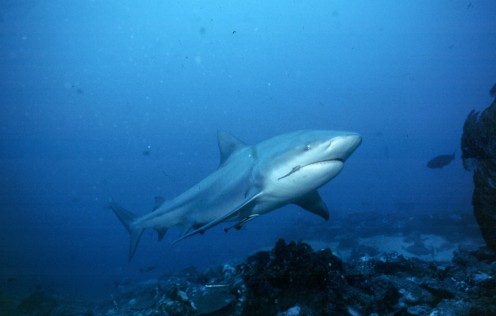
The bull shark is found in warm, shallow coastal waters and is fairly common worldwide. It can tolerate fresh water and may occasionally venture inland via a river. In the United States, they have been reported as far north as Indiana and Illinois in the Ohio and Mississippi Rivers respectively. It has a somewhat aggressive demeanor and can be quite unpredictable. Many researchers believe bull sharks are often responsible for attacks attributed to other species in many near-shore shark attacks.
A bull shark's diet is made up mostly of bony fish including other sharks and even bull sharks. They also will consume turtles, sea birds, dolphins and the occasional hippopotamus or other mammal that crosses its path. Bull sharks usually hunt alone or in pairs and are very protective of their territory, attacking other animals that may enter the area.
Shark Trivia
- Yes, sharks are fish.
- A shark's deadliest predator is another shark, as they will gladly eat each other.
- Sharks do not chew their food, ripping off chunks or swallowing it whole instead.
Buck-toothed Pool Shark (Carcharhinus dentus)

The buck-toothed pool shark, or the bucky as it is sometimes called, is one of the most plentiful sharks found in the southern United States. It is the only shark that can only be found in swimming pools, usually of the inflatable variety, and most often in the backyards of homes that have at least three vehicles on blocks in the front yard. The bucky is often found circling drunken blond females who may wander into the pool and almost without exception are usually fairly intoxicated themselves. While the bucky has been known to nibble on a blond now and then, they rarely actually bite. They do have the disturbing habit of occasionally relieving themselves in the pool.
Glossary
Barbel A slender whisker-shaped oran on some fish that is used to search for food in murky, dark water. Catfish, carp and sturgeon are three types of fish that have prominent barbels in addition to several species of sharks.
Commensal Having a relationship where in one party benefits from the relationship while the other party is neither harmed nor helped by the relationship. The shark-companion fish relationship usually fits this model with the fish benefiting and the shark being unaffected.
Dolphinfish There are two types of dolphinfish. The first is the mahi-mahi (or common dolphinfish) and the second is the pompano dolphifish. They are not related to dolphins, do not appear similar to dolphins, and as far as I know have no preference for the Miami Dolphins football team. I have no idea why they were named dolphinfish, but the important thing here is they sometimes will swim along as companion fish to sharks.
Feeding frenzy When a group of predators encounter a large supply of food (such as sharks coming across a school of fish), the predators may become highly agitated while quickly consuming as much food as possible, often biiting one another.
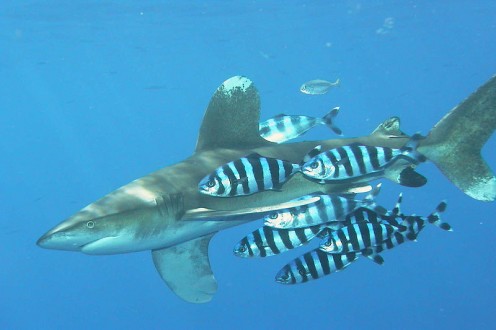
Pilot fish A carnivorous fish that often has a commensal relationship with sharks and other large sea creatures, usually eating parasites the host might pick up and scavenging leftovers generated by the host.
Remora Also known as suckerfish, sharksuckers, and whalesuckers, this long skinny fish is able to attach to sharks and other large sea creatures via its first dorsal fin that acts as a suction cup. Its primary purpose in doing so is transportation but it also feeds on the hosts leftovers and... um, well... its poop.

